Why now is the right time to buy and electric car
As the cost of petrol goes up and the price of electric vehicles comes down, sales of these high-performance cars have accelerated. But they’re not for everyone.
Lifestyle
Don't miss out on the headlines from Lifestyle. Followed categories will be added to My News.
These days, a trip to the petrol station is about as much fun as visiting the dentist.
If you’re not queuing behind someone doing their weekly grocery shop, you’re wincing at the soaring price of unleaded at the pump.
But a growing number of Australians have turned their back on the bowser for good.
Electric vehicle sales have surged this year on the back of generous government incentives that can make an EV cheaper than an equivalent petrol car for some buyers.
The key word here is some, though.
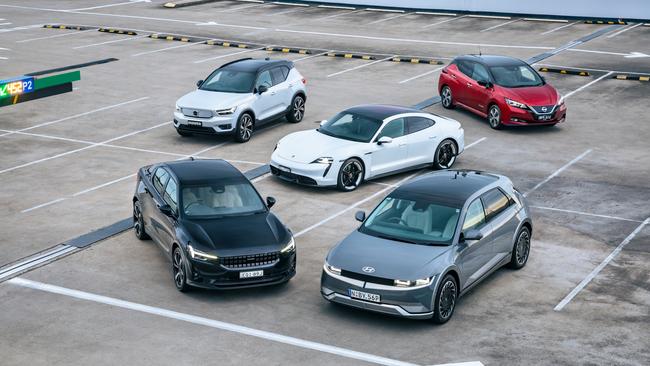
If you’re a tradie, a grey nomad or an apartment dweller, then an EV is probably not for you.
If you’re an executive on a good wage and lease your set of wheels through a salary sacrifice package, it’s a different story altogether.
The government’s recent decision to waive fringe benefits tax on salary packaged vehicles is being hailed a game changer.
Leasing experts estimate that under the new rules someone on a $100,000 salary can lease a Tesla Model 3, which retails for close to $65,000, for roughly the same weekly payments as a $35,000 Mazda CX-5 SUV.
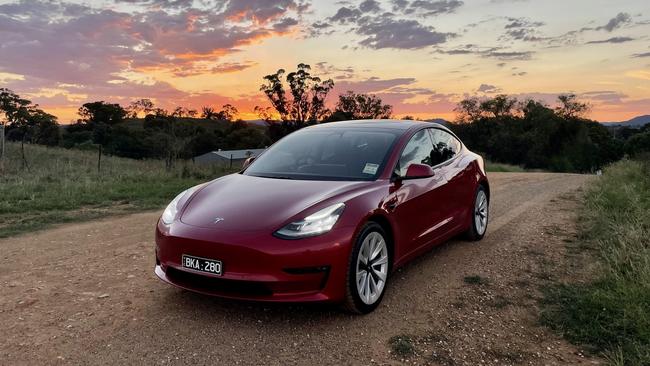
National Automotive Leasing and Salary Packaging Association secretary Rohan Martin says the new FBT rules have increased EV inquiries by “at least three to fourfold, if not more”. “This time 12 or so months ago EVs would have been around one to two per cent of all novated lease sales. That’s now probably closer to 10 to 15 per cent,” he says.
Australians bought 33,000 EVs last year, almost double the 2021 sales. In the first three months of this year, we’ve already snapped up more than 17,000. They remain a niche option, though, accounting for a little more than 6 per cent of the total market.
If you thought you could guess the typical EV buyer, think again.

Kia Australia marketing boss Dean Norbiato says the brand’s EV6 electric car turned the company’s demographics upside down. Roughly three-quarters of EV6 buyers are new to the brand and many are trading in a luxury car.
And contrary to popular perception, they’re not young, virtue-signalling tree huggers.
“While the expressions of interest we’ve had in our EVs skew towards younger buyers, the buyer is definitely the 50 to 60-year-old man who wants a car that says something about them. They want people to see them as advanced as an individual. It’s not so much about saving the planet,” he says.
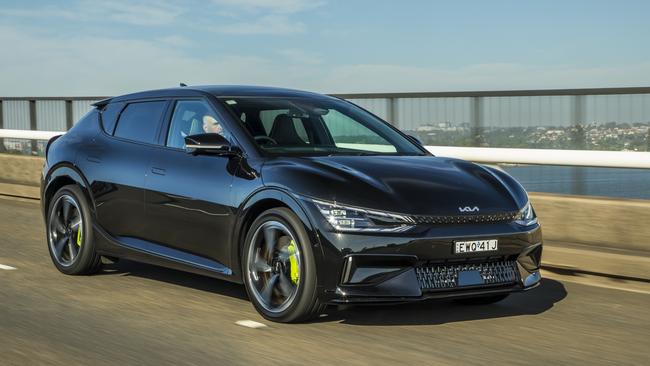
Performance is one of the key drivers, in particular for the EV6 GT, which accelerates faster than a standard Porsche 911. Performance is one of the top three reasons to buy,” Norbiato says.
Hyundai senior manager, direct to consumer, Andrew Stamatakis, says high petrol prices have also prompted interest in its Ioniq 5 and Ioniq 6 EVs. “It’s becoming more and more economically viable to buy an electric car because the price of fuel has gone up by so much,” he says.
Stamatakis says people are also drawn to the technology and the driving experience.
“They want to have a nice, tech-savvy car that doesn’t cost them much to run and could still blow the doors off an old V8 Commodore at the lights if they wanted to,” he says.
The environment isn’t a key driver of purchase decisions.
“It might be but it’s not really anything that’s come up in conversation with customers,” he says.

The ACT has announced a ban on petrol and diesel car sales from 2035 but the Federal Government is unlikely to follow suit.
Instead, it this week announced a mandated CO2 emissions target – with associated penalties – for car makers, which will force them to bring out more zero-emission vehicles.
Despite the dramatic rise in sales, Electric Vehicle Council chief executive Behyad Jafari concedes EVs aren’t suitable for everyone.
“It’s great that electric vehicle prices have come down so much and we now have $44,000 electric vehicles but that still means they are not quite ready for everyone yet,” Jafari says.
Price isn’t the only barrier.
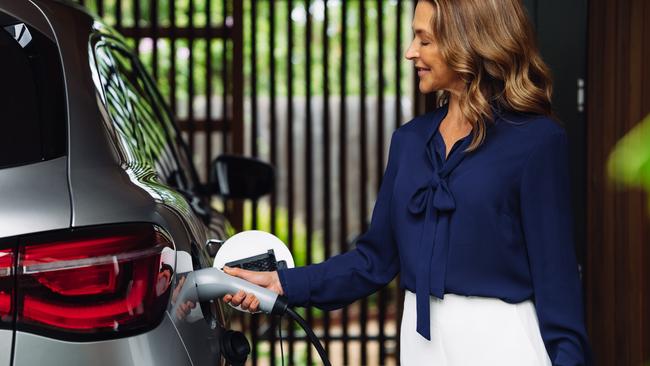
Australia’s recharging infrastructure is inadequate and you don’t have to search long to find social media posts about long queues, broken down chargers and frayed tempers during peak holiday periods.
Jafari acknowledges these “teething problems” but says most EV owners charge almost exclusively from home.
“If you can charge at home most of the time you’ll find an electric vehicle more convenient than a petrol or a diesel vehicle.”
He claims the real demand for EVs is much higher than sales figures suggest. “We already quite likely have 20 per cent of people who are buying cars that are ready to buy an electric vehicle but they can’t get their hands on them.”
There are, however, plenty of buyers who don’t have an EV option. Large, off-road wagons and utes make up roughly four out of every 10 new cars sold and there are no practical options for those buyers, who typically want to tow and take long road trips.

“Every market has its unique challenges,” Jafari says. “One of the things that’s brought up here is that we have a lot more larger vehicles and utes, but so do markets like the USA and they’re further ahead than we are.
“We do know there are more electric utes available in the rest of the world than are available in Australia.”
However, the current electric utes available overseas have their limitations.
EVs are racehorses, not draught horses. They’ll get you to 100km/h in a blink of an eye, but if you want to tow a caravan interstate, forget it. Overseas road tests have shown that the best electric utes can’t manage much more than 200km between charges when towing a serious load.
They also have bigger batteries, which take much longer to charge.
EVs also don’t make a lot of sense for the 15 per cent of people who live in apartments, or those who live in terraces without off-street parking. Some have resorted to running extension leads across footpaths to their car.
But Jafari says there are solutions to all of these problems. “The biggest challenges for charging in apartment buildings aren’t the technical challenges. Usually the bigger issue is dealing with the body corporate. So it’s social rather than technical,” he says.
The solution requires communal funding, as installing a charger in an apartment complex can cost tens of thousands of dollars.
“There’s quite a lot of people who are ready for electric vehicles and electric vehicles are ready for them and they should be able to go on that journey. This isn’t a decision being made whether or not we will shift to electric vehicles. That part’s going to happen so we have to be prepared for it.”
But one auto industry expert, who declined to be named, says most buyers won’t consider an EV purchase for some time.
“For most people, an EV is not going to be their next purchase or even the purchase after that,” he says.
TOP 5 EVS ON SALE
Sales of electric cars have soared by more than 150 per cent in the first three months of this year.
Most of the growth has come from Tesla, which accounts for roughly 60 per cent of the EV market.
Tesla Model 3
The Model 3 is easily the best-selling EV in the country.
While buyers have turned their backs on sedans over the past decade, the Tesla has wowed them with hi-tech extras including smartphone style “over-the-air” updates to key features. Performance is another drawcard. The cheapest Model 3, which starts at about $63,800, can sprint to 100km/h in a brisk 6.1 seconds, while the performance model is faster than a standard Porsche 911.

Tesla Model Y
The Model Y SUV shares the Model 3’s basic hardware but its higher roof liberates more headroom for rear passengers and impressive luggage space.
The long-range version will travel 533km between charges. It’s more expensive, though, at about $71,800 drive-away.
BYD Atto 3
The BYD name is relatively unknown in Australia but it’s the number one EV maker in the world.
The Atto 3 is a sharply priced, surprisingly roomy compact SUV that drives well.
Prices start at $49,100 drive-away for the standard range model, which can travel 400km between charges.
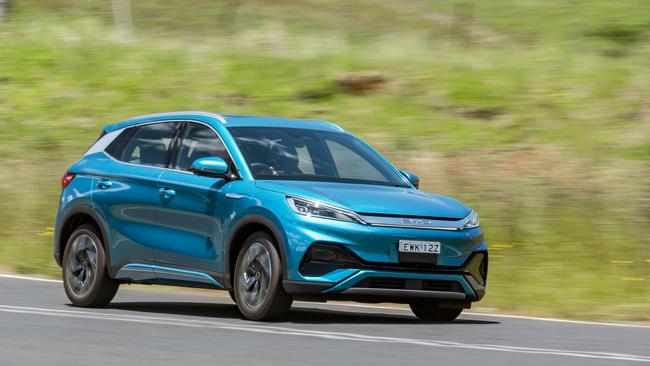
MG ZS EV
Priced from $45,700, the MG is the cheapest EV available. However, the range is lower than the Atto 3 at just 320km. The long-range version, which can travel 440km between charges, is $57,700 drive-away.
The ZS isn’t as roomy as the BYD but is well-appointed, with all the latest safety tech.
Volvo XC40 Recharge
The XC40 Recharge is the electric version of the petrol-powered XC40. It’s not cheap at roughly $78,000 drive-away (about $18,000 more than the cheapest petrol version) but the standard front-drive, single-motor version has a handy 510km of range and delivers brisk acceleration off the mark, combined with quality finishes in the cabin.



